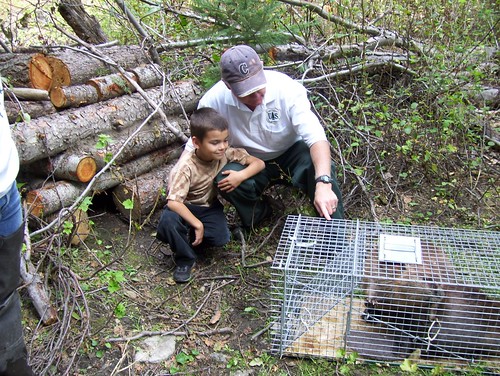
The Methow Beaver Project is a bit uncommon as far as forest health restoration projects go, because it relies on one of nature’s greatest engineers – the beaver.
Beavers build dams on rivers and streams, and build homes (“lodges”) in the resulting bodies of still, deep water to protect against predators. Beavers play an important ecological role, because the reservoirs of water that beaver dams create also increase riparian habitat, reduce stream temperatures, restore stream complexity, capture sediment, and store millions of gallons of water underground in wetland ‘sponges’ that surround beaver colonies. This benefits the many fish, birds, amphibians, plants and people that make up the entire ecosystem.
Across the country today, there are fewer beavers than there used to be because their fur was very desirable to early American settlers and many landowners considered them to be a pest that damaged the landscape. As beavers were eradicated, the once complex wetlands that they helped to create disappeared as well.
Recently, low snowpack in the Cascade Mountains has resulted in less meltwater flowing through streams throughout the spring, summer and fall on the Methow Valley Ranger District of the Okanogan-Wenatchee National Forest in north central Washington State. The low water levels have negatively affected habitat for salmon, trout, frogs, eagles and many other species. Over the next 20 to 30 years, dramatically less snowpack is predicted.
That’s why U.S. Forest Service biologists like Kent Woodruff are working to reintroduce beavers to forest streams where they used to be common. Beavers can help make such ecosystems more resilient to future changes in climate by restoring ecological function. Not only do beaver dams increase water storage on the landscape, they improve water quality by reducing stream temperatures, increasing nutrient availability in streams, and increasing stream function by reconnecting floodplains.
“We’re solving important problems one stick at a time,” Woodruff said.
Working with private landowners is an important component of this project. For beavers that are negatively impacting landowners with their activities, the project team helps to relocate the beavers to streams where their work is welcome. The project team provides a facility for short-term housing of beavers while sites are carefully prepared for their release. Release sites are monitored to measure the success of the reintroduction program. To evaluate long-term progress and results, stream temperatures and discharge are also being monitored. However, it can be said that no one is more meticulous about monitoring and maintaining these dams as the beavers themselves; beavers are constantly inspecting, repairing, and modifying their dams to maintain their homes and food supplies.
Since 2008, the project team has reached nearly 10,000 people through their education efforts. If you can’t get out to the Methow Valley to see the project in person, several videos are available. For more information, visit the Methow Beaver Project website.
A wide array of partners across sectors are working collaboratively on this project, including the Methow Salmon Recovery Foundation; U.S. Forest Service; Washington Departments of Fish and Wildlife, Natural Resources, and Ecology; Methow Conservancy; Yakama Nation; Confederated Tribes of the Colville Reservation; Wildlife Conservation Society; Methow Watershed Council; Pacific Biodiversity Institute; Ecotrust; U.S. Bureau of Reclamation; Salmon Recovery Funding Board; Douglas County and Grant County Public Utility Districts; Bonneville Environmental Foundation; National Forest Foundation; Seattle City Light; U.S. Fish and Wildlife Service; Woodsmith Watershed Consulting; and more than 100 community volunteers.
Recently, the Western Division of the American Fisheries Society recognized the Methow Beaver Project, awarding it the Riparian Challenge Award for 2015. This award recognizes and encourages excellence in riparian and watershed habitat management, and celebrates the accomplishments of the project’s many partners, including its beaver engineers!
This post is part of a series featuring the Forest Service’s work on restoration across the country.


